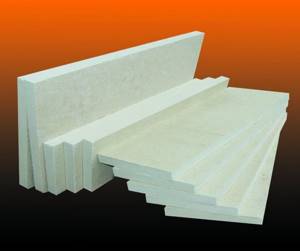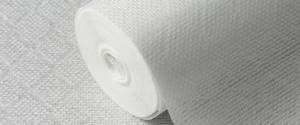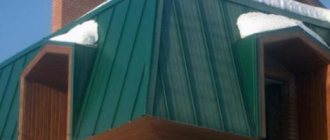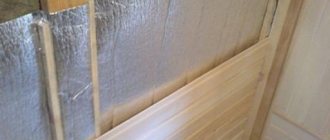The minimal open fires that every home has require careful attention. Non-combustible materials should be used to create comfortable and safe living conditions. Also, the use of fire-resistant boards, sheets or panels is also advisable in places where the presence of fire is not expected, for example in a roofing pie.
This review examines the concept of fire resistance (non-combustibility) in the context of building and finishing materials. Also presented are common non-combustible materials used at various stages of construction.
What is fire resistance of materials
Flammability should not be equated with fire resistance. Fire resistance means the ability of a building structure or material to resist the effects of fire and water in a fire.
The fire resistance limit is the time in minutes (in some cases, hours) from the start of a fire until the structure fails or warms up until the temperature on the surface opposite the fire rises to about 220°C, above which spontaneous ignition of organic materials is possible.
By structural failure we mean:
- Loss of bearing capacity.
- Collapse.
- Achieving irreversible deformations
- Formation of through cracks.
The fire resistance limit of wooden house elements is 15-20 minutes, steel frame ~ 30 minutes.
Combustible building materials are divided into:
| By flame spread over the surface | According to the toxicity of combustion products | ||
| G1 | Low flammable | T1 | Low risk. |
| G2 | Moderately flammable (organomineral materials) | T2 | Moderate danger. |
| G3 | Normally flammable | T3 | Highly dangerous. |
| G4 | Highly flammable (organic materials) | T4 | Extremely dangerous. |
Non-flammable materials include mineral materials: natural stones, concrete and mortars with mineral binders, ceramic and glass materials, metals.
Materials based on organic, plant components are normally and highly flammable . These include chipboard panels, fiberboard, and most synthetic plastic materials.
Low-flammable and moderately flammable are some organomineral materials that do not support combustion: fiberboard, wood concrete, wood impregnated with fire retardants. When exposed to open fire, they smolder, do not give open fire or become charred. Once the source of fire is eliminated, smoldering stops.
When exposed to fire, some organic materials do not produce an open flame, but sinter, melt and saturate the atmosphere with a number of gases harmful to human health. When burned, wood and polystyrene foam emit two types of gases (CO - carbon monoxide, CO2 - carbon dioxide), and plastics - phenol, aluminum oxide, sulfur and other harmful substances.
How to protect yourself from fire?
Based on all of the above, the following conclusions can be drawn:
- When choosing materials for finishing the facade of a house, it is necessary to take into account their flammability. Highly flammable, fire-hazardous solutions should be avoided.
- The ideal option for finishing a building, from a fire safety point of view, is NG material - non-flammable. It is also allowed to use finishing products belonging to group G1 (low-flammable).
- If there is a need to use a material of group G2 (moderate flammability) in finishing, it is important to use it in combination with mineral insulation (non-flammable stone wool).
- Wet facade finishing technology is considered a reliable solution. In this case, in combination with mineral-based decorative plaster (NG), conditionally non-flammable polystyrene foam (G1) can be used.
- High-quality thermal panels also belong to group G1. However, before buying panels, you need to make sure of their quality and safety. It is better to entrust this task to professionals.
- The use of wood and plastic siding in finishing is unsafe. Natural material requires effective fire protection treatment, and vinyl siding can only be installed with non-combustible insulation.
The best way to protect your house from fire is to entrust the finishing of the facade to experienced builders. We will select suitable materials and ensure their high-quality installation.
Foam glass is a non-flammable thermal insulation material
Foam glass blocks are made from glass powder that has undergone a sintering process. The chemical composition of foam glass is identical to the composition of classic glass and includes oxides of silicon, calcium, sodium, magnesium, and aluminum.
Foam glass
Foam glass is a completely non-flammable material. It contains no oxidizing or organic components. When foam glass is heated to high temperatures, it only melts (like ordinary glass) without releasing gases or vapors.
The service life of foam glass blocks while maintaining their protective characteristics is more than 100 years.
OLM for a bath
In saunas and bathhouses, protective fireproof screens for stoves are installed. Thermal insulation structures are made from various refractories. They offer more than two dozen composites and ceramics on sale. They are resistant not only to high temperatures, but also to aggressive gas environments. The materials were initially developed for use in critical industrial environments, and then adapted to everyday use. According to TU and GOST they are classified according to the following positions:
- Silica. They are made from high purity minerals and quartz. Their content in materials reaches 95%. Quartz-based products can withstand temperatures up to 2 thousand degrees C and aggressive influences.
- Alumina-based refractories sintered into blocks. The base can make up up to 90% of the total composition. This category includes fireclay and mullite bricks. This is the optimal solution for fireplaces and stoves running on natural fuel.
- Magnesian. The products are made from oxides of various metals through sintering at high temperatures. It is resistant to aggressive environments and temperatures up to 2 thousand degrees C.
- Minirite slabs. They are made from environmentally friendly raw materials and have high heat-resistant characteristics. Up to 90% of the composition is cement reinforced with fibrous materials. When heated, they increase slightly in size, so during installation you should leave small gaps between the sheets.
Important! Officially, metal is not a fire insulator, but it is often used as such to protect building structures from the heat and flames of stoves and fireplaces. Steel has the highest heat reflection coefficient parameters; it is not afraid of sudden and significant temperature changes.

Mullite heat-resistant brick
Non-flammable wallpaper for walls
Fiberglass wallpaper (glass wallpaper) has fire-resistant properties. The fibers are made from quartz sand, soda, dolomite and lime.

Glass wallpaper
Non-combustible glass wallpaper is intended for finishing all types of buildings and has the following properties:
- The wallpaper is environmentally friendly.
- Convenient to use.
- Does not absorb foam.
- Wallpaper can be washed.
- Material made from fibers perfectly absorbs deformation forces (for example, from plaster).
Using a special self-adhesive tape in the seams when painting, you can completely eliminate the visibility of the seams.
Fiberglass wallpaper is available in both white and colored. They may differ in density, strength, texture and pattern.
Fire-resistant vermiculite boards for walls, roofs and chimneys
Vermiculite boards are fire-resistant materials and have the following properties:
- They are chemically neutral.
- They are inert and do not have alkaline impurities.
- Not subject to corrosion.
- Can be processed with conventional paints and adhesives.
- They do not require any protective measures during installation and operation.
- In fire conditions they do not emit toxic or other harmful substances.

Vermiculite slabs
Such slabs are made by hot pressing from a composition based on calcined expanded vermiculite, liquid glass and inorganic targeted additives, which in the event of a fire provides the highest degree of fire protection for any structures (including metal ones).
During the firing process, vermiculite can increase its volume by 10–15 times. After cooling, the material retains its acquired shape.
Scope of application of vermiculite:
- Fire protection for load-bearing metal structures and air ducts with a fire resistance limit of 0.75-2.5 hours.
- Fire protection of wooden, including load-bearing building structures with a fire resistance limit of 0.75-2.5 hours.
- Increasing the fire resistance of metal air ducts, shafts, casings, sleeves, cable ducts, fire barriers.
- Used in the manufacture of fireproof doors, valves, safes, partitions and suspended ceilings
- It is used for structural thermal protection and fire protection of chimneys during the installation of fireplaces, stoves and other energy equipment.
Fire retardant efficiency group, depending on the thickness of the vermiculite: group 1 (at least 150 minutes) with a material thickness of 48 - 50 mm; Group 2 (at least 120 minutes) with a material thickness of 32-40 mm; Group 3 (at least 60 minutes) with a material thickness of 20-25 mm.
Non-flammable and non-fire hazardous insulation
If the building requires additional thermal insulation, insulation is used when finishing the facade. When choosing an insulating material, among other things, its flammability should be taken into account. The use of highly flammable insulation is unacceptable. In most cases, they choose mineral wool or expanded polystyrene.

Non-flammable stone wool
Rock wool (mineral wool) is rightfully considered the best insulation in terms of fire resistance. This insulation is made from molten glass or basalt. Both materials do not burn, so thermal insulation based on them belongs to the NG group (non-flammable).
Non-flammable stone wool, in addition to not burning, is an excellent insulation material, and also improves the sound insulation of walls. For installation of the material, special facade dowels are used.
Non-flammable polystyrene foam
A worthy alternative to stone wool is expanded polystyrene (foam). However, not every type of polystyrene foam is suitable for construction. For fire safety purposes, only low-flammable modifications of polystyrene foam boards with high density are used.
Foam plastics that are safe in terms of flammability include PPS F material - it has a shorter self-burning time compared to conventional polystyrene foam. Various density options are available for sale - 16, 22, 30 kg/m3 and others.
Mineral wool fire retardant products
Mineral wool fibers are able to withstand temperatures above 1000°C without melting. In the process, at temperatures above 250°C, the binders of the material evaporate, and the fibers, due to chaotic adhesion, provide cohesion and sufficient strength, creating protection from fire.

Mineral wool fire retardant products
Mineral wool fire-retardant materials are successfully used for insulating fireplace and stove pipes, external walls, roofs, and floors.
Magnesium glass panels - a universal fire-resistant finishing material
Magnesium glass sheet is a finishing material based on shavings, magnesium chloride and fiberglass. It is flexible, durable, fireproof and moisture resistant.
The reinforcing fiberglass mesh in the composition allows the glass-magnesium sheet to bend with a radius of curvature of up to three meters. Thanks to this, the material is convenient to use on uneven surfaces without the risk of sheet fracture.

Magnesium glass panels
This fire-resistant material is environmentally friendly. Even when heated, it does not release toxic substances.
Price for non-combustible wall panels
The cost of non-combustible panels depends on:
the thickness of the SML slab, the type of decorative coating applied (painting, PVC film, hpl plastic), the number of panels in a one-time order, the need for cutting to customer dimensions, the cost of delivery from our production to the customer’s site. All these parameters are important for calculating the final cost!!!
Please send your request to the email address listed on the website, or fill out the convenient electronic form below.
Also select the color and type of coating from the catalogs of decorative coatings in the next section, indicate the selected article in the request.
Fire retardants to improve fire resistance
Fire retardants are special substances that increase the fire resistance of initially combustible materials.
Basic requirements for fire retardants:
- Preventing combustion and smoldering of the protected material.
- Not capable of causing corrosion of metal parts.
- Ability to act over a long period of time.
- Fire retardants should not increase the hygroscopic properties of wood.
- Harmless to people and animals.
- The compositions should not affect paint coatings or create difficulties during mechanical processing of the material.
One of the best fire retardants is disubstituted ammonium phosphate (diammonium phosphate). When heated, it releases phosphorus oxides, which cover the wood with a protective film, and a non-flammable gas - ammonia. Diammonium phosphate is usually used in a mixture with ammonium sulfate.
There are two types of fire retardant compounds, which are based on fire retardants:
- For deep fire-retardant impregnation of lumber under pressure in industrial autoclave installations.
- For surface fire retardant treatment. This type includes traditional mortars used on construction sites, in attics, on roofs, and rafter systems. The method of application in this case is with paint brushes, rollers, spraying with construction spray guns in two layers with a significant drying period between layers.
Fireplace cladding
Fireplaces are lined with stone, fireclay, marble, ceramic tiles and other non-combustible materials. When decorating a fireplace with natural stone, an additional foundation is made.
To decorate fireplaces, they use natural stone soapstone, which can withstand loads and is heat-intensive. Plates made from this material:
- protect stoves, fireplaces, chimney ducts;
- lining the walls and floor of the bathhouse;
- They make heated floors and walls with electric cables.
The stone was first mined in Finland. Talkomagnesite can withstand heating and cooling without losing its shape or color. Lining the stove with stone creates a healthy microclimate in the room and saves fuel. The technology for lining stoves came from Finland.
Price of the stone: 8000 rubles (sq. meter).
Thermal boxes for fireplaces are assembled and adjusted in production. Various shades of marble are used for installation. The protective casing is made according to individual projects, and ready-made claddings can be selected on the manufacturers’ websites.
Fire resistant paint
Fire retardant paint is a mixture of binder, pigment and filler. Such compositions are often prepared using potassium liquid (silicate) glass. Also included in appropriate proportions are fire-resistant fillers, white, colored pigment, potassium liquid glass and special additives. Ground vermiculite, perlite, talc, kaolin wool fibers, and fluffed asbestos are most often used as fillers.
Fire-resistant paint is capable of spontaneous hardening, and the resulting film can serve both for fire protection and for decorative purposes.
Fire-resistant paints on liquid glass are used for interior finishing work and to increase the fire resistance of wooden structures made of fiberboard (fibreboard) and chipboard (chipboard). Organosilicate compositions can be used for painting exterior elements and metal structures.
Installation of non-combustible wall panels
Installation of non-flammable panels based on SML is carried out quite quickly and only requires care when performing the work. Aluminum profiles are used for installation. Their design allows you to hide corners and joints between connected sheets. Profiles can be painted in different colors, which increases the aesthetic qualities of the installed material. Installation does not require the use of any liquids or solutions. This allows you to get rid of dirt that is usually formed during finishing work using water-based mixtures. The profile installation method prevents subsequent possible destruction of the panels or the appearance of cracks in the event of transportation or settlement of the building. Thanks to these qualities, the material is suitable for the construction of new houses.











